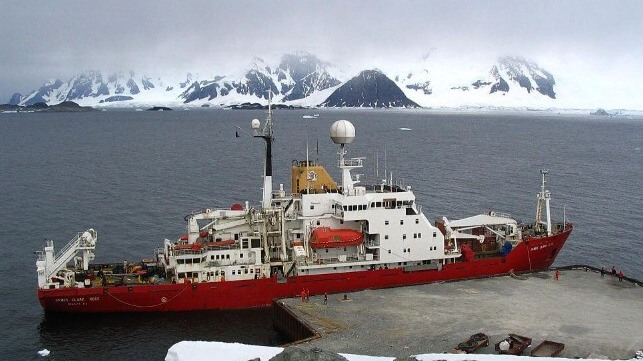Ukraine's Icebreaker is Stranded in Punta Arenas

Ukraine’s first scientific Antarctic expedition in 20 years is on the verge of aborting its mission. The country’s research icebreaker is stranded in Chile due to the Russian invasion, and the prospects for its next voyage are uncertain.
Two months after research icebreaker Noosfera departed from its home seaport in Odesa for a mission in Antarctica, her 26 crew members are now stranded in the Chilean southern port of Punta Arenas. The crew consists of both Ukrainian and foreign specialists who previously worked for the British Antarctic Survey.
Noosfera, the flagship of the Ukrainian scientific fleet, left Odesa on January 28. It is on its first voyage to Antarctica since its acquisition by the Ukrainian National Antarctic Scientific Centre (NASC) in August last year. The icebreaker’s Antarctic expedition marked the first time Ukraine was returning to study the Southern Ocean after a 20 year break.
Reports indicate that Noosfera arrived in Punta Arenas on March 14 for a stopover before continuing its journey to Ukraine's Akademik Vernadsky polar station, but the vessel was unable to proceed with its mission.
“It is too difficult for all the crew, they started to worry, thinking a lot about their families,” Capt. Pablo Panasyuk, Noosfera’s master, told Reuters.
According to NASC, Noosfera was supposed to make a stopover in Punta Arenas, where a second group of scientists and specialists would join the ship. The new team would relieve the 12 scientists, engineers and support staff who have been manning the polar station for the past 13 months.
Noosfera was also to deliver a variety of cargoes to the station, ranging from annual supply of provisions to building materials and equipment. After unloading the vessel, a scientific program lasting several weeks was scheduled for the Atlantic sector of the Antarctic and in the area around the Antarctic Peninsula.
The Vernadsky station is Ukraine's only research base in Antarctica and is located on Galindez Island, off the west coast of the Antarctic Peninsula. It was originally established as the British Antarctic Survey’s Faraday Station, but was transferred to Ukraine under an agreement between the British Antarctic Survey and the NASC in 1996.
Built by Swan Hunter Shipbuilders in Wallsend, UK and launched in 1990, Noosfera was originally called the RRS James Clark Ross. She was part of Britain’s research vessel fleet until her sale last year. The 99-meter icebreaker carries a crew of 27 and can accommodate up to 50 scientists.
Top image: RRS James Clark Ross at Rothera, 2010 (William M. Connelley / CC BY 3.0)
